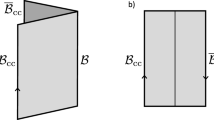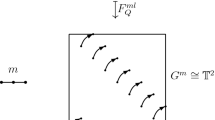Abstract
Using ideas from Jones, lattice gauge theory and loop quantum gravity, we construct \(1+1\)-dimensional gauge theories on a spacetime cylinder. Given a separable compact group G, we construct localized time-zero fields on the spatial torus as a net of C*-algebras together with an action of the gauge group that is an infinite product of G over the dyadic rationals and, using a recent machinery of Jones, an action of Thompson’s group T as a replacement of the spatial diffeomorphism group. Adding a family of probability measures on the unitary dual of G we construct a state and obtain a net of von Neumann algebras carrying a state-preserving gauge group action. For abelian G, we provide a very explicit description of our algebras. For a single measure on the dual of G, we have a state-preserving action of Thompson’s group and semi-finite von Neumann algebras. For \(G={\mathbf {S}}\) the circle group together with a certain family of heat-kernel states providing the measures, we obtain hyperfinite type III factors with a normal faithful state providing a nontrivial time evolution via Tomita–Takesaki theory (KMS condition). In the latter case, we additionally have a non-singular action of the group of rotations with dyadic angles, as a subgroup of Thompson’s group T, for geometrically motivated choices of families of heat-kernel states.
Similar content being viewed by others
References
Arici, F., Stienstra, R., van Suijlekom, W.: Quantum lattice gauge fields and groupoid C*-algebras. Annales Henri Poincaré 19(11), 3241–3266 (2018)
Arveson, W.B.: An Invitation to C*-Algebras. Graduate Texts in Mathematics, vol. 39, 1st edn. Springer, New York (1976)
Ashtekar, A., Lewandowski, J.: Representation theory of analytic holonomy C*-algebras. In: Baez, J.C. (ed.) Knots and Quantum Gravity, pp. 21–62. Oxford University Press, Oxford (1994)
Ashtekar, A., Lewandowski, J.: Differential geometry on the space of connections via graphs and projective limits. J. Geom. Phys. 17(3), 191–230 (1995)
Ashtekar, A., Lewandowski, J.: Projective techniques and functional integration for gauge theories. J. Math. Phys. 36(5), 2170–2191 (1995)
Ashtekar, A., Lewandowski, J., Marolf, D., Mourão, J.M.C., Thiemann, T.: Quantisation of diffeomorphism invariant theories of connections with local degrees of freedom. J. Math. Phys. 36, 6456–6493 (1995)
Ashtekar, A., Lewandowski, J., Marolf, D., Mourão, J., Thiemann, T.: SU(N) quantum Yang–Mills theory in two dimensions: a complete solution. J. Math. Phys. 38(11), 5453–5482 (1997)
Baez, J.C.: Spin networks in gauge theory. Adv. Math. 117, 253–272 (1996)
Belk, J.: Thompson’s group F. Ph.D. thesis, Cornell University (2004)
Blackadar, B.E.: Operator Algebras: Theory of C*-Algebras and von Neumann Algebras. Encyclopaedia of Mathematical Sciences, vol. 122. Springer, Berlin (2006)
Borchers, H.-J.: On revolutionizing quantum field theory with Tomita’s modular theory. J. Math. Phys. 41(6), 3604–3673 (2000)
Bratteli, O., Robinson, D.W.: Operator Algebras and Quantum Statistical Mechanics 1: \({C}^{*}\)- and \({W}^{*}\)-Algebras, Symmetry Groups, Decomposition of States. Theoretical and Mathematical Physics, 2nd edn. Springer, Berlin (1987)
Bratteli, O., Robinson, D.W.: Operator Algebras and Quantum Statistical Mechanics 2: Equilibrium States, Models in Quantum Statistical Mechanics. Theoretical and Mathematical Physics, 2nd edn. Springer, Berlin (1997)
Brothier, A.: Haagerup property for wreath products constructed with Thompson’s groups. Preprint, arXiv:1906.03789 (2019)
Brothier, A., Jones, V.F.R.: On the Haagerup and Kazhdan property of R. Thompson’s groups. J. Group Theory 22(5), 795–807 (2019). https://doi.org/10.1515/jgth-2018-0114
Brothier, A., Jones, V.F.R.: Pythagorean representations of Thomspon’s groups. J. Funct. Anal. 277(7), 2442–2469 (2019). https://doi.org/10.1016/j.jfa.2019.02.009
Brothier, A., Stottmeister, A.: Canonical quantization of \(1+1\)-dimensional yang-mills theory: an operator-algebraic approach. Preprint, arXiv:1907.05549 (2019)
Cannon, J., Floyd, W., Parry, W.: Introductory notes on Richard Thompson’s groups. Enseign. Math. 42, 215–256 (1996)
Choksi, J.R., Kakutani, S.: Residuality of ergodic measurable transformations and of ergodic transformations which preserve an infinite measure. Indiana Univ. Math. J. 28(3), 453–469 (1979)
Connes, A.: Noncommutative Geometry, 1st edn. Academic Press, San Diego (1994)
Creutz, M.: Quarks, Gluons and Lattices. Cambridge Monographs on Mathematical Physics. Cambridge University Press, Cambridge (1985)
Dimock, J.: Canonical quantization of Yang–Mills on a circle. Rev. Math. Phys. 8, 85–102 (1996)
Driver, B.K., Hall, B.C.: Yang–Mills theory and the Segal–Bargmann transform. Commun. Math. Phys. 201(2), 249–290 (1999)
Evans, D.E., Kawahigashi, Y.: Quantum Symmetries on Operator Algebras, p. 848. Oxford University Press, Oxford (1998)
Evenbly, G., Vidal, G.: Tensor network renormalization. Phys. Rev. Lett. 115(18), 1–14 (2015)
Evenbly, G., Vidal, G.: Tensor network renormalization yields the multiscale entanglement renormalization ansatz. Phys. Rev. Lett. 115, 200401 (2016)
Fernández, R., Fröhlich, J., Sokal, A.D.: Random Walks, Critical Phenomena, and Triviality in Quantum Field Theory. Texts and Monographs in Physics. Springer, Berlin (1992)
Gabbiani, F., Fröhlich, J.: Operator algebras and conformal field theory. Commun. Math. Phys. 155(3), 569–640 (1993)
Grundling, H.: A group algebra for inductive limit groups. Continuity problems of the canonical commutation relations. Acta Appl. Math. 46, 107–145 (1997)
Grundling, H., Rudolph, G.: QCD on an infinite lattice. Commun. Math. Phys. 318, 717–766 (2013)
Grundling, H., Rudolph, G.: Dynamics for QCD on an infinite lattice. Commun. Math. Phys. 349, 1163–1202 (2016)
Haag, R.: Local Quantum Physics: Fields, Particles, Algebras. Theoretical and Mathematical Physics, 2nd edn. Springer, Berlin (1996)
Huebschmann, J., Rudolph, G., Schmidt, M.: A gauge model for quantum mechanics on a stratified space. Commun. Math. Phys. 286, 459–494 (2009)
Jones, V.F.R.: Some unitary representations of Tompson’s groups F and T. J. Combin. Algebra 1(1), 1–44 (2017)
Jones, V.F.R.: A no-go theorem for the continuum limit of a periodic quantum spin chain. Commun. Math. Phys. 357(1), 295–317 (2018)
Jones, V.F.R.: Scale invariant transfer matrices and Hamiltonians. J. Phys. A: Math. Theor. 51, 104001 (2018)
Kakutani, S.: On equivalence of infinite product measures. Ann. Math. 49(1), 214–224 (1948)
Kogut, J.B.: The lattice gauge theory approach to quantum chromodynamics. Rev. Mod. Phys. 55(3), 775–836 (1983)
Kogut, J.B., Susskind, L.: Hamiltonian formulation of Wilson’s lattice gauge theories. Phys. Rev. D: Part. Fields 11, 395–408 (1975)
Landsman, N.P.: Rieffel induction as generalized quantum Marsden–Weinstein reduction. J. Geom. Phys. 15, 285–319 (1995)
Lang, T., Liegener, K., Thiemann, T.: Hamiltonian renormalisation I: derivation from Osterwalder–Schrader reconstruction. Class. Quantum Gravity 35(24), 245011 (2017)
Löffelholz, J., Morchio, G., Strocchi, F.: Mathematical structure of the temporal gauge in quantum electrodynamics. J. Math. Phys. 44, 5095–5107 (2003)
Mal’tsev, A.: Nilpotent semigroups. Uchen. Zap. Ivanovsk. Ped. Inst. 4, 107–111 (1953)
Sengupta, A.N.: The Yang–Mills measure and symplectic structure over spaces of connections. In: Quantization of Singular Symplectic Quotients. Progress in Mathematics, vol. 198, pp. 329–355. Birkhäuser, Basel (2001)
Stottmeister, A., Thiemann, T.: Coherent states, quantum gravity, and the Born–Oppenheimer approximation. II. Compact Lie groups. J. Math. Phys. 57, 073501 (2016)
Stottmeister, A., Thiemann, T.: Coherent states, quantum gravity, and the Born–Oppenheimer approximation. III. Applications to loop quantum gravity. J. Math. Phys. 57, 083509 (2016)
Takesaki, M.: Theory of Operator Algebras. II. Encyclopaedia of Mathematical Sciences, vol. 125. Springer, Berlin (2003). Operator Algebras and Non-commutative Geometry, 6
Takesaki, M.: Theory of Operator Algebras. III. Encyclopaedia of Mathematical Sciences, vol. 127. Springer, Berlin (2003). Operator Algebras and Non-commutative Geometry, 8
Thiemann, T.: Modern Canonical Quantum General Relativity. Cambridge Monographs on Mathematical Physics. Cambridge University Press, Cambridge (2007)
Timmermann, T.: An Invitation to Quantum Groups and Duality. EMS Textbooks in Mathematics. European Mathematical Society, Zürich (2008)
Velhinho, J.M.: Functorial aspects of the space of generalized connections. Mod. Phys. Lett. A 20(17–18), 1299–1303 (2005)
Vidal, G.: A class of quantum many-body states that can be efficiently simulated. Phys. Rev. Lett. 101(11), 110501 (2008)
Wilson, K.G.: Renormalization group and critical phenomena. I. Renormalization group and the Kadanoff scaling picture. Phys. Rev. B: Condens. Matter Mater. Phys. 4(9), 3174–3183 (1971)
Wilson, K.G.: Renormalization group and critical phenomena. II. Phase-space cell analysis of critical behavior. Phys. Rev. B: Condens. Matter Mater. Phys. 4(9), 3184–3205 (1971)
Witten, E.: On quantum gauge theories in two dimensions. Commun. Math. Phys. 141(1), 153–209 (1991)
Wren, K.K.: Quantization of constrained systems with singularities using Rieffel induction. J. Geom. Phys. 24, 173–202 (1998)
Acknowledgements
Part of this project was done when both authors were working at the University of Rome, Tor Vergata thanks to the very generous support of Roberto Longo. We are very grateful to Roberto for giving us this great opportunity besides his constant encouragement and support during various stages of the project. AS thanks the Alexander-von-Humboldt Foundation for generous financial support during his stay at the University of Rome, Tor Vergata. Moreover, AS acknowledges financial support and kind hospitality by the Isaac Newton Institute and the Banff International Research Station where parts of this work were developed. Furthermore, we are grateful to Thomas Thiemann, Yoh Tanimoto, Luca Giorgetti and Vincenzo Morinelli for comments and discussions during various stages of this work. Finally, we are grateful to the referee for constructive comments which improved the clarity of this manuscript.
Author information
Authors and Affiliations
Corresponding author
Additional information
Communicated by Y. Kawahigashi
Publisher's Note
Springer Nature remains neutral with regard to jurisdictional claims in published maps and institutional affiliations.
Both authors were partially supported by European Research Council Advanced Grant 669240 QUEST. AS was supported by Alexander-von-Humboldt Foundation through a Feodor Lynen Research Fellowship. AB is supported by a University of New South Wales Sydney starting Grant.
Rights and permissions
About this article
Cite this article
Brothier, A., Stottmeister, A. Operator-Algebraic Construction of Gauge Theories and Jones’ Actions of Thompson’s Groups. Commun. Math. Phys. 376, 841–891 (2020). https://doi.org/10.1007/s00220-019-03603-4
Received:
Accepted:
Published:
Issue Date:
DOI: https://doi.org/10.1007/s00220-019-03603-4




